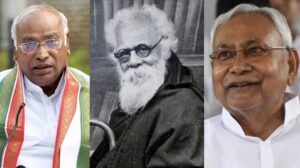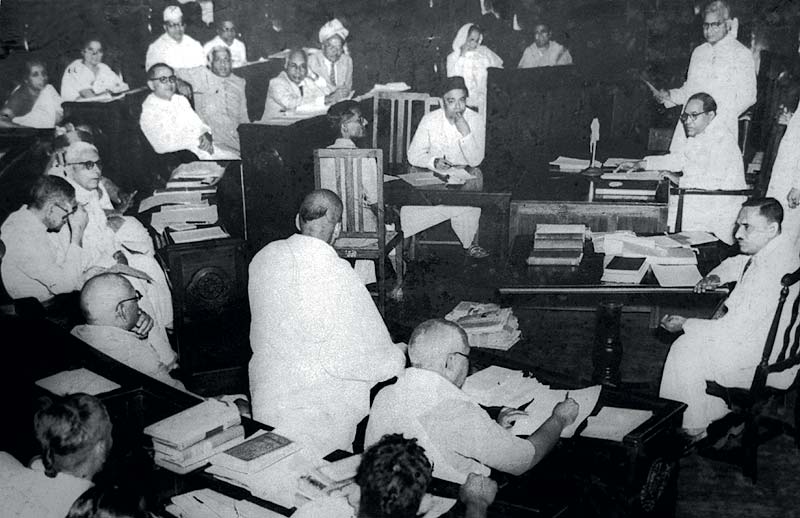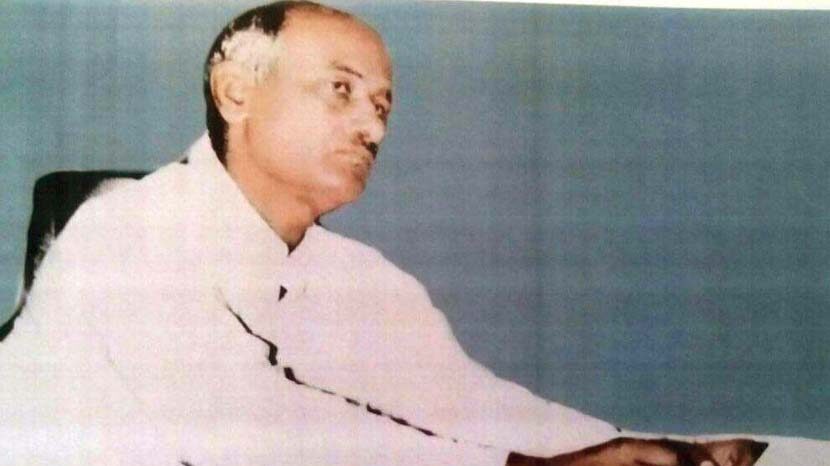Periyar E.V.R. (17 September 1879 – 24 December 1973)
“Periyar was not a scholar. In fact he had very little schooling. But he was a great man and an original thinker and had a vision, which can see through the mist of time and point his unerring finger towards what the country needs for the future. But people tried to bite his finger instead of looking at the direction he was pointing at. He could pierce the curtain of the future, visualize and give shape to the mysteries still in the womb of time. His thinking was far ahead of his times and he was a standing example of the well known dictum, what ‘he thinks today, the country will think tomorrow’,” wrote Justice P. Venugopal, former judge of the Madras High Court in the preface of The Five Prolonged Battle of Periyar: For An Egalitarian Society. His words look embodied today both in letter and spirit.
In 1925, Periyar E.V.R. had quit the Congress Party solely over the question of proportional representation. At the Madras Provincial Congress Committee session held at Kancheepuram in November 2025, he moved a resolution supporting communal representation. The president of that particular session, T.V.K. Mudaliar, demanded signatures of 30 delegates in favour of this resolution. But despite 50 signatures which Periyar and his supporters gathered, the motion was declined, which led to division of the party delegates.
Addressing this same divided session of the Congress party, Periyar had roared, “We are talking about making sacrifices for Swaraj. If we attain Swaraj, it must be Swaraj for all. Today, there is a fear in the minds of our people that Swaraj would be the ‘Brahmins Raj in toto’. We must instil confidence in them. Different communities in India should be cordial with one another. We must see to it that every community is secure and thriving. Today, millions of people are in a pitiable state. They are dumb. The only way to render them social justice is to give legitimate representation in all walks of life.”
It is well known how Periyar’s crusade for self-respect and proportional representation in the sphere of education and employment bore intended fruits in the state of Tamil Nadu. Indeed, it has become a model (the Dravidian Model of Social Justice) for other states and the Indian Republic as a whole to emulate. Today, on 24 December 2023, the 50th death anniversary of Periyar, it is worth reflecting upon what Periyar stood for and what India can learn from him to realize his unfinished agenda of social justice.
Periyar: An icon of rationalism and self-respect
I started reading Periyar slightly late but as I have found out it is better late than never. I am reminded of my school days, where our vernacular teacher would often compare two world-famous literary luminaries located in entirely different time and space. For example, “Kalidasa was Indian Shakespeare” or vice versa. While reading ideas of Karl Marx in the past, I often wondered why we never had an indigenous revolutionary thinker or philosopher who took the world head on and declared that “religion is an opium of the masses” or as he fittingly pointed out, “how the philosophers have only interpreted the world in various ways; the point however was to change it”. Now, while reading up on Periyar’s thought and actions, I felt that in many ways he is the “Indian Karl Marx”. Noted historian M.S.S. Pandian has stated that Periyar’s rationalism in relation to religion can be summed up in a single slogan which he popularized throughout his post-nationalist political career, “… he who created god was a fool, he who spreads his name is a scoundrel and he who worships him is a barbarian.”
While reading about Periyar’s crusade against religiosity, one is bound to contrast him with the armchair intellectuals in India who have only bothered to theorize the irrationality of religion and superstition and not devised any concrete tool for liberation of those enslaved by such irrational thinking. Periyar was fully aware that many of his actions would not only be considered as blasphemous by the reactionary forces but would attract wrath and violence too. But he took a firm stand.
During the Vaikom [temple] Satyagraha, Periyar dubbed the idol of Vaikom “a mere piece of stone fit only to wash dirty linen with”. In 1953, while leading an agitation for breaking the Pillayar (Ganesha) idol, he remarked that “we have to eradicate the gods who are responsible for the institution which portray us as Shudras, people of low birth, and some others as Brahmins of high birth. While the former go on toiling, without any education, the latter can remain without exerting themselves. We have to break the idol of these gods. I start with Ganesha because it is he who is worshipped before undertaking any task …”
Periyar understood that self-respect has to be generated in individuals before it is translated into a collective conscience. He firmly believed that social reform was not enough of an agency for the regeneration of India as a nation. In his presidential address to the South Indian Social Reformers’ Conference on 26 November 1928, he reiterated, “…society in my humble opinion has degenerated to an extent that it is impossible to remedy by social reform. The much talked-about social reform of the present day is one of the crafty weapons of the educated and the wealthy classes who are competing with one another in an attempt to gain popularity and influence over the people. Such methods of social reform are not intended to confer any benefit on those for whose welfare they are intended. These methods are adopted to serve the selfish interest of the so-called social reformers themselves … the most important of the evils that stares us in our face is that which is responsible for division of the people into superiors and inferiors in society on the basis of birth …”
The Self-Respect Movement was started by Periyar EVR to instil pride among the Non-Brahmin masses about their identity and get them to own their Dravidian past. It stood with absolute denial of birth-based superiority to those being born as Brahmins. It espoused outright rejection of the mythological construction of the Sanatana Dharma, of which Hinduism too is an offshoot. The notion of Varnashram Dharma stood as a pillar on the plinth of religiosity and this pillar could only be brought down by striking at the base.
On 30 January 1929, Ms Gnanam, explaining the philosophical basis of the Self-Respect Movement, stated that this movement stood for the social regeneration of the masses as well as the classes. It sought to create an ideal society built upon the bedrock of equality and fraternity in all spheres of life. It further aimed for a complete equality not just between man and man but also between man and woman. In a nutshell, this movement stood for complete secularization of life.
Dravidian model of social justice: Why proportional representation?
The demand for proportional representation arose from the historical denial of education to a large section of the population based on the birth-based caste system. For an inclusive development of India as a republic, and to ensure social justice for every Indian citizen, adequate representation of the excluded social groups was a necessity. In the Madras Presidency, the idea of proportional representation emerged at the beginning of the 20th century. Some progressive Dravidian leaders published the militant Non-Brahmin Manifesto in 1916 which exposed the Brahmin monopoly in government jobs and educational institutions. The Non-Brahmin Manifesto remains a historic document that exposed the domination of 97 per cent majority Non-Brahmins by 3 per cent minority Brahmins. Later, on 20 December 1916, some highly educated and socially conscious leaders started The South Indian Liberal Federation (SILF), popularly known as the Justice Party.
Social Justice formed the core of the agenda of the Justice Party. The Justice Party government issued the Communal Government Order on 16 September 1921, which would undergo several amendments. Meanwhile, Periyar’s pursuit of a resolution to secure proportional representation in the Congress party miserably failed. After several failed attempts, he left the Congress party in 1925 and established the Self-Respect Movement. Once the Constitution of India was finally enacted on 26 January 1950, Alladi Krishnaswamy Iyer, a member of the Constitution Drafting Committee, filed a case in the Madras High Court for Ms Champkam Dorairajan against the communal order. They managed to have the Brahmin-monopolized Madras High Court scrap the Communal Government Order which had ensured proportional representation in “Dravidian land” during the colonial rule. On 14 August 1950, Periyar EVR, then the leader of Dravidar Kazhagam, called for a huge protest. Both the Dravidar Kazhagam and its breakaway political party the Dravida Munnetra Kazhagam held huge protests in Madras.

While preparing and mobilizing for the protest to be held two days later, Periyar delivered a speech on 12 August 1950. He requested the students to boycott their classes and shopkeepers to close their shops in solidarity. While addressing them he argued that “the demand for communal reservation is not just a recent development. It is being spoken of from 1916-17. Our leaders and thinkers had demanded reservation in education and official jobs, in proportion to their population. All those who made this demand were in the Congress party till 1916-17. Such leaders left the Congress party after they realized that there was no scope for this demand in the Congress party and that this party was working only in the interest and welfare of a small group. After this these leaders made their demand very forcefully, for communal reservation and for the welfare of the backward classes …”
As a result of this robust mobilization in the Dravidian land, the Government of India was forced to enact the First Constitutional Amendment Act in 1951. The thus amended Clause 4 to Article 15 of the Indian Constitution now reads: “Nothing in this article or in clause (2) of article 29 shall prevent the State from making any special provision for the advancement of any socially and educationally backward classes of citizens or for the Scheduled Castes and the Scheduled Tribes.” This bedrock of social justice laid by Periyar was so strong that various Chief Ministers of Tamil Nadu, even though belonging to different political ideologies, kept adding to the reservations for the marginalised groups.
In 1971, M. Karunanidhi became Chief Minister. He raised the reservation for the Backward Classes from 25 per cent to 31 per cent and the reservation for the Scheduled Castes and Scheduled Tribes together from 16 per cent to 18 per cent. Thus the total proportion of the reserved seats in public education and employment of the state was raised to 49 per cent. In 1980, when M.G. Ramchandran became chief minister, he further raised the quota for the Backward Classes from 31 per cent to 50 per cent, meaning that the total reserved quota became 68 per cent. Finally, during 1989-91, M. Karunanidhi yet again expanded the ST quota by 1 per cent. The present DMK government led by Chief Minister MK Stalin has already supported the demand for reservation for Dalit Christians and Dalit Muslims and the state assembly has already passed a resolution to this effect.
50 per cent reservation: A false ceiling
In the historic judgment Indra Sawhney and Others vs Union of India, popularly known as the Mandal judgment, a Bench comprising nine judges of the Supreme Court put a ceiling of 50 percent for reservations and added a caveat to exclude the “creamy layer” from reservation for the Other Backward Classes (OBCs). Since then, the brahmanical, casteist anti-reservation intelligentsia and media have created an atmosphere of despair and tried cementing a common sense that the 50 per cent quota is all that they can “sacrifice” and it should never surpass that limit. However, the followers of Periyar championed the cause of social justice and showed the rest of the country that any ceiling on democratic representation would ultimately prove to be a “glass-ceiling” that needs to be broken. Even those who opposed reservation would go on to introduce 10 per cent reservation for the upper castes, over and above the 50 per cent reservations for the historically marginalized sections, on the pretext of providing representation to Economically Weaker Sections (EWS).
A careful reading of the same aforementioned judgment leaves scope for breaking this ceiling. It says that “while fifty percent shall be the rule, it is necessary not to put out of consideration certain extraordinary situations inherent in the great diversity of this country and the people. It might happen that in far-flung remote areas, the population inhabiting those areas might, on account of their being out of the mainstream of national life and in view of conditions peculiar to and characteristic to them, need to be treated in a different way, some relaxation in this strict rule may be imperative. In doing so, extreme caution is to be exercised and a special case made out”.
That ceiling having been imposed by the Supreme Court, Tamil Nadu’s 69 per cent reservation was challenged but it was the organization that Periyar left behind, Dravidar Kazhagam, which held huge protests across Tamil Nadu. The Dravidar Kazhagam proposed that a Bill on the reservation policy of the state be enacted by the state legislature and have the Parliament amend the Constitution to place the Tamil Nadu law in the Ninth Schedule in accordance with Article 31B of the Constitution. Upon the Constitutional Amendment getting the assent of the President of India, the Tamil Nadu law would become immune to judicial review. Thus, in 1994 the Seventy-Sixth Constitutional Amendment saw light of the day due to the unparalleled efforts of the Dravidar Kazhagam under the able leadership of Dr K. Veeramani who then served as its general secretary.
Dr Veeramani, who closely worked with Periyar, continues to head the organization. In 2016, while delivering his speech at a national seminar titled “Challenges of Backward Classes” in Bengaluru, organized by the Karnataka State Backward Classes Commission, he rightly observed that “the monopoly of reservation is not the invention of the backward or depressed or downtrodden. It was started by Manu, the doyen of social injustice, by dividing the society under four varnas in the Vedic or Brahmanic religion.”
Today, the Bihar Assembly has cleared 65 per cent reservation for the marginalized sections based on the findings of a caste survey held in the state. The time is ripe for demanding a nationwide caste census. Even the Congress has joined the pro-social-justice regional parties in demanding a caste census. The BJP-led Union government has dragged its feet in holding a caste census, although Home Minister Amit Shah said recently in the run-up to the Telangana Assembly Elections that his party, the BJP, was never opposed to a caste based census. As the RSS-backed BJP keeps changing its goal posts, only a Periyar-like commitment to rationalism and principles of social justice will make India a true republic.
The same Congress Party which Periyar quit about a century ago after it refused to consider proportional representation is now toeing the Periyar line and demanding a caste census. Of course, caste census is just the means, proportional representation is the end. What Periyar thought 100 years ago, the country is thinking now.





